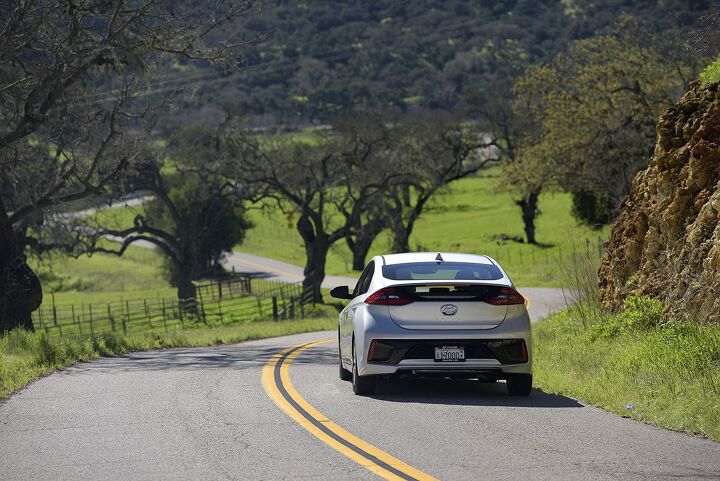The Dead Zone: New Roadside Service Sees Electric Hyundais Take One for the Team

Reading about Hyundai’s new customer service program, it’s hard not to think of the M*A*S*H episode where a supply shortage forces the surgeons to donate their own blood to the patients they’re operating on.
That’s very similar to how Hyundai Canada’s just-announced “Charge Here” service works. Unlike in the United States, where EV drivers stranded with a drained battery can pick up the phone (in some markets) and call AAA for a top-up, no such service exists in the Great White North. With its first electric model now plying the country’s roadways, the automaker figured the best way to help stranded Ioniq Electric drivers was with other Ioniq Electrics.
The service, which starts in the EV-heavy Montreal area this spring, sees Ioniqs come to the aid of overly optimistic drivers sidelined by their car’s modest 124-mile range. The savior Ioniq drains 7 kWh of juice from its own battery to the recipient car, resurrecting it with about 25 miles of range — enough to make it home or to a public charging station.
The hookup lasts about 20 minutes. A trunk-mounted converter and two Level 3 charging cables allow the donor car to reverse the normal flow of electrons — out from the car’s charge port to the convertor, and then on to the dead vehicle.
“It’s still early days for the adoption of battery electric vehicles by customers in Canada,” said Don Romano, president and CEO of Hyundai Auto Canada, in a statement. “We often hear from customers hesitant to make the switch to an EV that they are concerned about range. Frankly, we can’t blame them as no one wants to be stranded on the side of the road. So, with Hyundai Charge Here, we’re giving EV owners peace-of-mind that Hyundai can help them get home or to a nearby charging station.”
Hyundai Canada’s offering the complimentary service as part of its roadside assistance program, available without cost for five years after the purchase of a battery electric Hyundai. It’s also studying “whether the program should eventually be expanded to other regions.”
Choosing Montreal as the debut city was an easy choice, as 50 percent of Ioniq Electric sales arise from Quebec. The model’s availability remains limited in the U.S., however, with sales relegated just to California.
It’s worth noting that Tesla’s roadside assistance program covers towing for battery or drivetrain issues, but doesn’t offer roadside recharging or tows for vehicles with a discharged battery. Still, Fred Lambert will surely come up with a reason to call Hyundai’s service a dumb idea.
Interestingly, in 2016, five years after it started its roadside EV recharging service, AAA commented on how seldom customers used it. Apparently, nervous EV drivers automatically give themselves a 20 percent “reserve” while driving.
A man’s got to know his (car’s) limitations.
[Images: Steph Willems/TTAC, Hyundai]

More by Steph Willems
Latest Car Reviews
Read moreLatest Product Reviews
Read moreRecent Comments
- Tassos Jong-iL North Korea is saving pokemon cards and amibos to buy GM in 10 years, we hope.
- Formula m Same as Ford, withholding billions in development because they want to rearrange the furniture.
- EV-Guy I would care more about the Detroit downtown core. Who else would possibly be able to occupy this space? GM bought this complex - correct? If they can't fill it, how do they find tenants that can? Is the plan to just tear it down and sell to developers?
- EBFlex Demand is so high for EVs they are having to lay people off. Layoffs are the ultimate sign of an rapidly expanding market.
- Thomas I thought about buying an EV, but the more I learned about them, the less I wanted one. Maybe I'll reconsider in 5 or 10 years if technology improves. I don't think EVs are good enough yet for my use case. Pricing and infrastructure needs to improve too.


































Comments
Join the conversation
I live in the western suburbs of DC. Plenty of charging stations; they do have an app for that. There's even chargers at the Organic Food Store, thanks Mom's. Most EV drivers know how much "juice" they have like most ICE drive know how much gas they have. The arguments about that can go into "Some nuns who took orphans to the mall and missed their bus and needed a ride home" category/anecdotal proof category. I know two Tesla Type S owners; both former Special Forces officers. Accela is the most comfortable way to go from DC to NYC. The bus is chepaer, 20$ each way. I'm waiting for one of the national truck stop chains to install chargers for EV's. Pull-in, plug-in, go to the bathroom, maybe eat, get some coffee. Oh, I forget most TTAC readers drive non-stop for eight hours without stopping, drink from their thermos and eat two pre-made bologna sandwiches on their journey.
This is a really clever engineering trick. Modern version of a gas tank siphon.